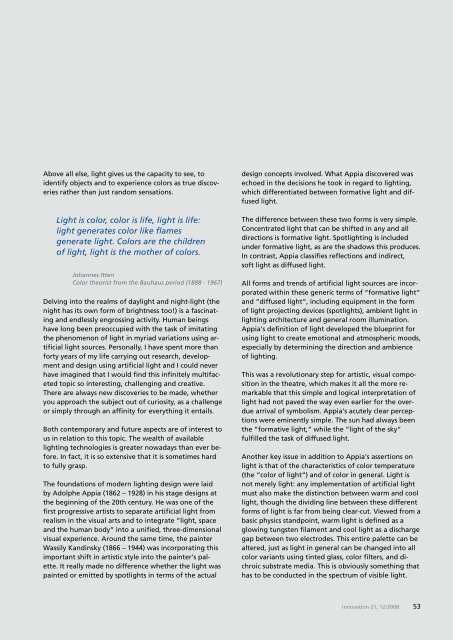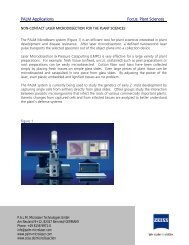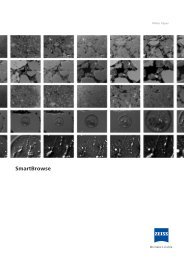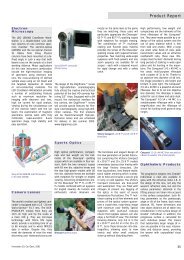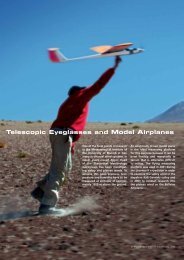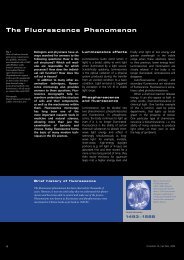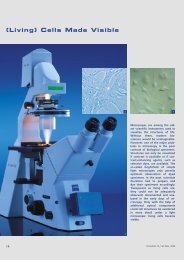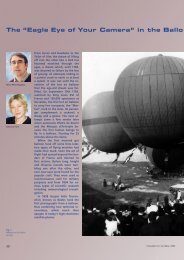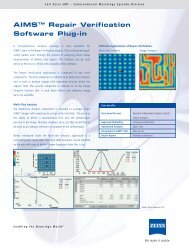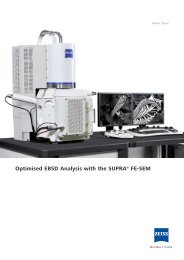Living Images: Fluorescence microscopy Camera Lens ... - Carl Zeiss
Living Images: Fluorescence microscopy Camera Lens ... - Carl Zeiss
Living Images: Fluorescence microscopy Camera Lens ... - Carl Zeiss
You also want an ePaper? Increase the reach of your titles
YUMPU automatically turns print PDFs into web optimized ePapers that Google loves.
Above all else, light gives us the capacity to see, to<br />
identify objects and to experience colors as true discoveries<br />
rather than just random sensations.<br />
Light is color, color is life, light is life:<br />
light generates color like flames<br />
generate light. Colors are the children<br />
of light, light is the mother of colors.<br />
Johannes Itten<br />
Color theorist from the Bauhaus period (1888 - 1967)<br />
Delving into the realms of daylight and night-light (the<br />
night has its own form of brightness too!) is a fascinating<br />
and endlessly engrossing activity. Human beings<br />
have long been preoccupied with the task of imitating<br />
the phenomenon of light in myriad variations using artificial<br />
light sources. Personally, I have spent more than<br />
forty years of my life carrying out research, development<br />
and design using artificial light and I could never<br />
have imagined that I would find this infinitely multifaceted<br />
topic so interesting, challenging and creative.<br />
There are always new discoveries to be made, whether<br />
you approach the subject out of curiosity, as a challenge<br />
or simply through an affinity for everything it entails.<br />
Both contemporary and future aspects are of interest to<br />
us in relation to this topic. The wealth of available<br />
lighting technologies is greater nowadays than ever before.<br />
In fact, it is so extensive that it is sometimes hard<br />
to fully grasp.<br />
The foundations of modern lighting design were laid<br />
by Adolphe Appia (1862 – 1928) in his stage designs at<br />
the beginning of the 20th century. He was one of the<br />
first progressive artists to separate artificial light from<br />
realism in the visual arts and to integrate “light, space<br />
and the human body“ into a unified, three-dimensional<br />
visual experience. Around the same time, the painter<br />
Wassily Kandinsky (1866 – 1944) was incorporating this<br />
important shift in artistic style into the painter's palette.<br />
It really made no difference whether the light was<br />
painted or emitted by spotlights in terms of the actual<br />
design concepts involved. What Appia discovered was<br />
echoed in the decisions he took in regard to lighting,<br />
which differentiated between formative light and diffused<br />
light.<br />
The difference between these two forms is very simple.<br />
Concentrated light that can be shifted in any and all<br />
directions is formative light. Spotlighting is included<br />
under formative light, as are the shadows this produces.<br />
In contrast, Appia classifies reflections and indirect,<br />
soft light as diffused light.<br />
All forms and trends of artificial light sources are incorporated<br />
within these generic terms of “formative light“<br />
and “diffused light“, including equipment in the form<br />
of light projecting devices (spotlights), ambient light in<br />
lighting architecture and general room illumination.<br />
Appia's definition of light developed the blueprint for<br />
using light to create emotional and atmospheric moods,<br />
especially by determining the direction and ambience<br />
of lighting.<br />
This was a revolutionary step for artistic, visual composition<br />
in the theatre, which makes it all the more remarkable<br />
that this simple and logical interpretation of<br />
light had not paved the way even earlier for the overdue<br />
arrival of symbolism. Appia's acutely clear perceptions<br />
were eminently simple. The sun had always been<br />
the “formative light,“ while the “light of the sky“<br />
fulfilled the task of diffused light.<br />
Another key issue in addition to Appia's assertions on<br />
light is that of the characteristics of color temperature<br />
(the “color of light“) and of color in general. Light is<br />
not merely light: any implementation of artificial light<br />
must also make the distinction between warm and cool<br />
light, though the dividing line between these different<br />
forms of light is far from being clear-cut. Viewed from a<br />
basic physics standpoint, warm light is defined as a<br />
glowing tungsten filament and cool light as a discharge<br />
gap between two electrodes. This entire palette can be<br />
altered, just as light in general can be changed into all<br />
color variants using tinted glass, color filters, and dichroic<br />
substrate media. This is obviously something that<br />
has to be conducted in the spectrum of visible light.<br />
Innovation 21, 12 / 2008<br />
53


